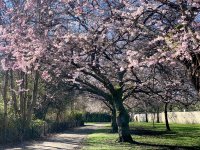I signed up for Volunteer Seabirds at Sea (VSAS) survey training a couple of months ago and this took place yesterday and today. This training is run by one of the programme participants, JNCC. The surveys are part of a European programme and involve volunteer surveyors (like the people being trained this weekend) paired with mentors (more experienced surveyors) who go on ferries on the west coast of Scotland and survey the seabirds and a selection of other species like cetaceans, sunfish and basking sharks. The programme has been hampered by Covid but it is now picking up again. They run surveys at the moment on the Ardrossan - Arran and Kennacraig - Islay ferries. They also run others out of Oban (and one other that escapes my memory) but as these ferries require volunteers to go into the bridge, this has been put on hold as they don't want volunteers mixing with the crew.
They've also been trying to arrange surveys from cruise ships and research ships too - with one planned before Covid hit from Oban to Iceland. What a trip that would be! They're also talking about expanding to England soon, and hopefully Wales and Northern Ireland at some point.
Yesterday was a classroom session in Saltcoats learning the theory about the surveys. I only had a short time available before the training and at lunch to visit the waterfront, but there were redshank, oystercatcher, curlew.
Today we had the practical training. This involved two return trips back to back on the Ardrossan - Arran ferry. There wasn't a great variety of birds it must be said, with the most frequently seen birds were guillemot. We saw some razorbill too, especially closer to Ardrossan. I saw my first gannet of the year, just the one as we returned to Ardrossan on the last crossing. Other highlights were great black-backed gull, a number of immature kittiwakes, shag, cormorant, black guillemot, eider, red-breasted merganser. In addition to these birds we saw lots of harbour porpoise on each crossing, common seal just outside Brodick and I saw a swimming otter off Brodick too.
Edit: I forgot to mention the immature herring gull that was trying to eat a starfish on Brodick pier. A few minutes later an adult herring gull dropped a mussel from a height on to the pier to crack it open, and flying across the bay two ravens. On the way home, there was a field full of geese, pretty sure they were pink-footed, 100+, and nearby a common buzzard. Distant view from a bus.
No sign of any puffins. They nest to the south on Ailsa Craig, but only in small numbers, so it wasn't entirely unexpected to not see any. No terns either. And no divers - further north around Bute seems to be a hotspot for them just now.
I'm hoping to do the minimum of three surveys a year so I can be accredited. But just from a person point of view, it gives me a reason for getting on to the ferries throughout the year. It'll be interesting to see how the bird (and non-bird) population changes as the year progresses. They do winter trips too, and I can imagine they'll be particularly freezing trips since you're right at the front of the ferries.






